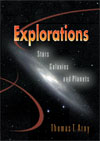The Solar System consists of the Sun and the bodies orbiting in its gravitational
field: the nine planets, their moons, and swarms of asteroids and comets. In
this chapter, we will survey the general properties of this system and describe
its birth, reserving for later chapters more detailed descriptions of its components.
Although earthlings have not walked on any Solar System objects except the Earth
and Moon, we have detailed pictures sent to us from spacecraft of most of the
planets and their satellites. Some are naked spheres of rock; others are mostly
ice. Some have thin, frigid atmospheres so cold that ordinary gases crystallize
as snow above their cratered surfaces; others have thick atmospheres the consistency
of wet cement and no solid surface at all. On Mars, a dead volcano over twice
the height of Mount Everest looms above a red desert. On Uranus, an ocean thousands
of miles deep heaves beneath poisonous clouds. Yet despite such diversity, the
Solar System possesses an underlying order, an order from which astronomers
attempt to read the story of how our Solar System came to be. As long ago as the eighteenth century, astronomers recognized that the
highly ordered pattern in which the planets move is a clue to their origin.
All the planets circle the Sun in the same direction, and all lie within a region
of space shaped like a flattened disk, as we can directly infer from their motion
within the zodiac. That pattern suggested to those early astronomers that the
planets formed from a vast, spinning disk of gas and dust surrounding the Sun.
As they learned more about the planets from more powerful telescopes and from
the spectral analysis of their light, astronomers discovered a second underlying
pattern. Despite major visible surface differences, the planets form two main
families: solid, rocky bodies composed mainly of silicates (like the Earth)
and lying near the Sun, and liquid and gaseous bodies rich in hydrogen (like
Jupiter) and lying far from the Sun. From these and other regularities, astronomers hypothesize that the Sun
and planets formed from the collapse of a huge, slowly spinning cloud of gas
and dust. Most of the cloud's material fell inward and ended up in the Sun,
but in response to rotation, some settled into a swirling disk around it. Then,
within that disk, dust particles coagulated--perhaps aided by electrostatic
effects such as those that make lint cling to your clothes to form pebble-sized
chunks of material, which in turn collided and sometimes stuck, growing ever
larger to become the planets we see today. The type of planet formed rocky or
gaseous depended strongly on the temperature and hence the place in the disk
where it condensed. Near the Sun's fiery surface, only dust with a high melting point could
form from the original gases, and so planets there became masses of rock and
metal such as the Earth. But in the bitterly cold regions far from the Sun,
ice and frozen gas could condense as well as rock and metals. Thus, planets
such as Jupiter are rich in these lighter materials. However, regardless of
their composition, the objects that formed in the disk retained the motion of
the original gas and dust, and so we see them today, moving in a flattened system,
all orbiting the Sun in the same direction. How long ago did all this happen?
From the amount of radioactivity in meteorites, astronomers estimate the Solar
System formed about 4.5 billion years ago. With this overview in mind, we can
now look in more detail at what our Solar System is like and how astronomers
think it formed. |



 2002 McGraw-Hill Higher Education
2002 McGraw-Hill Higher Education